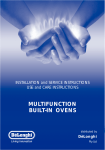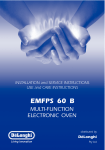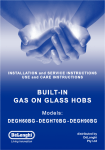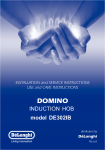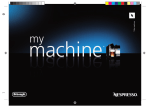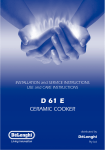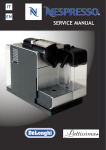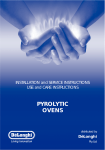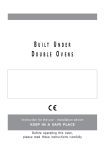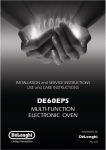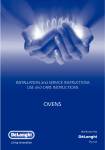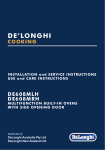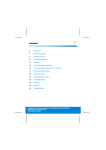Download DeLonghi DE 91 MPS Oven User Manual
Transcript
INSTALLATION and SERVICE INSTRUCTIONS USE and CARE INSTRUCTIONS DE 91 MPS MULTIFUNCTION BUILT-IN OVEN distributed by DèLonghi Pty Ltd Dear Customer, Thank you for having purchased and given your preference to our product. The safety precautions and recommendations reported below are for your own safety and that of others. They will also provide a means by which to make full use of the features offered by your appliance. Please keep this booklet in a safe place. It may be useful in future, either to yourself or to others in the event that doubts should arise relating to its operation. This appliance must be used only for the task it has explicitly been designed for, that is for cooking foodstuffs. Any other form of usage is to be considered as inappropriate and therefore dangerous. The manufacturer declines all responsibility in the event of damage caused by improper, incorrect or illogical use of the appliance or be faulty installation. PRODUCT LABEL This oven has been designed and constructed in accordance with the following codes and specifications: AS/NZS 60335-1 General Requirements for Domestic electrical appliances AS/NZS 60335-2-6 Particular Requirements for Domestic electrical cooking appliances 2 AS/NSZ 1044 Electromagnetic Compatibility Requirements. CONTENTS Precautions and recommendations ................................................” 3-4 Installation......................................................................................” 5 Use and care .................................................................................” Cooking with multifunction oven ...............................................” Clock/Timer with “Touch control” keys........................................” 11 16 24 Cleaning and maintenance............................................................” 27 IMPORTANT PRECAUTIONS AND RECOMMENDATIONS FOR USE OF ELECTRICAL APPLIANCES Use of any electrical appliance implies the necessity to follow a series of fundamental rules. In particular: ■ Never touch the appliance with wet hands or feet; ■ Do not operate the appliance barefooted; The appliance is not intended for use by young children or infirm persons without supervision; ■ Young children should be supervised to ensure they do not play with the appliance. The manufacturer cannot be held responsible for any damages caused by improper, incorrect or illogical use of the appliance. ■ USING THE OVEN FOR THE FIRST TIME You are advised to carry out the following operations: Furnish the interior of the oven. ■ Switch the empty oven ON at maximum temperature for about two hours to eliminate traces of grease and smell from the components. ■ Let the oven cool down, switch off the electrical supply, then clean the inside of the oven with a cloth soaked in water and neutral detergent and dry thoroughly. ■ 3 IMPORTANT PRECAUTIONS AND RECOMMENDATIONS After having unpacked the appliance, check to ensure that it is not damaged. In case of doubt, do not use it and consult your supplier or a professionally qualified technician. Packing elements (i.e. plastic bags, polystyrene foam, nails, packing straps, etc.) should not be left around within easy reach of children, as these may cause serious injuries. ■ Do not attempt to modify the technical characteristics of the appliance as this may become dangerous to use. ■ Do not carry out cleaning or maintenance operations on the appliance without having previously disconnected it from the electric power supply. ■ After use, ensure that the knobs are in the off position. ■ ■ ■ ■ ■ ■ ■ ■ ■ Fire risk! Do not store flammable material in the oven. ■ Always use oven gloves when removing the shelves and food trays from the oven whilst hot. Do not hang towels, dishcloths or other items on the appliance or its handle – as this could be a fire hazard. Clean the oven regularly and do not allow fat or oils to build up in the oven base or tray. Remove spillages as soon as they occur. Do not stand on the open oven door. Always stand back from the appliance when opening the oven door to allow steam and hot air to escape before removing the food. This appliance is for domestic use only. Safe food handling: leave food in the oven for as short a time as possible before and after cooking. This is to avoid contamination by organisms which may cause food poisoning. Take particular care during warmer weather. The manufacturer declines all liability for injury to persons or damage to property caused by incorrect or improper use of the appliance. ■ ■ ■ ■ ■ ■ ■ ■ ■ 4 During and after use of the appliance, certain parts will become very hot. Do not touch hot parts. Care should be taken to avoid touching heating elements inside the oven. Household appliances are not intended to be played with by children. Keep children away from the oven during use. Children, or persons with a disability which limits their ability to use the appliance, should have a responsible person to instruct them in its use. The instructor should be satisfied that they can use the appliance without danger to themselves or their surroundings. Some appliances are supplied with a protective film on steel and aluminium parts. This film must be removed before using the appliance. Make sure that electrical cables connecting other appliances in the proximity of the oven do not become entrapped in the oven door. Do not line the oven walls with aluminium foil. Do not place baking trays or the drip tray on the base of the oven chamber. WARNING When correctly installed, your product meets all safety requirements laid down for this type of product category. However special care should be taken around the rear or the underneath of the appliance as these areas are not designed or intended to be touched and may contain sharp or rough edges, that may cause injury. WARNING: Taking care NOT to lift the oven by the door handle. IMPORTANT NOTE: This appliance shall not be used as a space heater, especially if installed in marine craft or caravans. INSTALLATION CAUTION: ■ ■ ■ ■ ■ This appliance must be installed in accordance with these installation instructions. This appliance shall only be serviced by authorized personnel. This appliance is to be installed only by an authorised person. Incorrect installation, for which the manufacturer accepts no responsibility, may cause personal injury or damage. Always disconnect the oven from mains power supply before carrying out any maintenance operations or repairs. ELECTRICAL REQUIREMENTS ■ ■ ■ ■ ■ ■ ■ ■ N.B. The oven is supplied without a power supply plug and therefore if you are not connecting directly to the mains, a standardized plug suitable for the load must be fitted. Connection to the mains must be carried out by qualified personnel in accordance with current regulations. The appliance must be connected to the mains checking that the voltage corresponds to the value given in the rating plate and that the electrical cable sections can withstand the load specified on the plate. The plug must be connected to an earthed socket in compliance with safety standards. The appliance can be connected directly to the mains placing a two pole switch with minimum opening between the contacts of 3 mm between the appliance and the mains. The power supply cable must not touch the hot parts and must be positioned so that it does not exceed 75°C at any point. Once the appliance has been installed, the switch or socket must always be accessible. If the supply cord is damaged it must be replaced by the manufacturer or its Service Agent or a similarly qualified person in order to avoid a hazard. • The connection of the appliance to earth is mandatory. • For connection to the mains, do not use adapters, reducers or branching devices as they can cause overheating and burning. If the installation requires alterations to the domestic electrical system call a qualified electrician. He should also check that the socket cable section is suitable for the power drawn by the appliance. 5 REPAIRS REPLACING THE POWER SUPPLY CABLE ■ ■ ■ Unhook the terminal board cover by inserting a screwdriver into the two hooks A (fig. 2). Open the cable gland by unscrewing screw F (fig. 3), unscrew the terminal screws and remove the cable. The new supply cable, of suitable type and section, is connected to the terminal board following the diagram of fig. 1. FEEDER CABLE SECTION TYPE HO5RR-F ~ 240 V ~ 230 V 3050 W (13.26 A) 3 x 1,5 mm2 3320 W (13.83 A) 3 x 1,5 mm2 Figure 1 220 - 240 V L1 N (L2 ) E Figure 2 Figure 3 F A 6 ELECTRIC DIAGRAM Figure 4 F1 TM TL TL1 PR LF S1 S2 C G S CIR V Oven switch Oven thermostat Thermal overload (N.C.) Thermal overload (N.O.) Electronic programmer Oven lamps Thermostat pilot lamp Line pilot lamp Top element Grill element Bottom element Circular element Fan motor CF GIR M MT T Cooling fan motor Rotisserie Terminal block Testing block Earth connection 7 FITTING REQUIREMENTS The appliance should be installed by a QUALIFIED INSTALLATION TECHNICIAN. The appliance must be installed in compliance with regulations in force. The walls surrounding the oven must be made of heat-resistant material. WARNING: Taking care NOT to lift the oven by the door handle. The oven can be fitted in standard units, width 90 cm and depth 60 cm. Installation requires a compartment as illustrated in figures 5 and 6. On the lover side, the oven must lay on supports standing the oven weight. min. 860 480 467 478 853 m 896 54 22 min. 900 min. 860 480 467 478 853 m 896 54 22 Figure 6 8 4 0 55 in. 5 in. 50 4 Figure 5 WARNING When correctly installed, your product meets all safety requirements laid down for this type of product category. However special care should be taken around the rear or the underneath of the appliance as these areas are not designed or intended to be touched and may contain sharp or rough edges, that may cause injury. FIXING THE OVEN Introduce the oven into the furniture opening and fix it with 4 screws (not supplied) as figure 7. It is essential that the oven rests on a surface which will support its weight, as the screw fixing is only complementary. Adjust the hinges of furniture doors adjacent to the oven to allow a 4-5 mm gap between the furniture door and the oven frame. Figure 7 9 Figure 8 OVEN DOOR LOWER TRIM AIR FLOW IMPORTANT: To avoid damage to the lower trim please note the following instructions. The lower trim is designed to allow for good air circulation and the correct opening of the oven door. To ensure the trim is not damaged due to the appliance being placed on the floor, the appliance should be suitably supported as in above illustration. After installation the appliance door should be slowly opened to ensure no damage has occurred. No responsibility for lower trim damage will be accepted if these instructions have not been followed. 10 USE and CARE CAUTION: ■ This appliance must be used only for the task it has explicitly been designed for, that is for domestic cooking of foodstuffs. Any other form of usage is to be considered as inappropriate and therefore dangerous. ■ Do NOT place combustible materials or products on this appliance at any time. USING THE OVEN FOR THE FIRST TIME Operate as follows: Assemble the wire racks on the oven walls using the 2 screws, interposing the catalytic panels A with the arrow up (fig. 9). The catalytic panel with the hole for the rotisserie must be positioned on the right oven wall. DO NOT INTERPOSE THE CATALYTIC PANEL WITHOUT THE HOLE ON THE RIGHT OVEN WALL. ■ Slide in the grease filter on the back of the oven as in Fig. 11. ■ Slide in, on the guides, the shelf and the tray (fig. 10). The rack must be fitted so that the safety catch, which stops it sliding out, faces the inside of the oven. ■ To eliminate traces of grease in manufacture it is necessary to pre-heat the oven at the maximum temperature: • For 60 minutes in the position, for 30 minutes in the position and for another 15 minutes in the position. ■ Figure 9 HOLE FOR ROTISSERIE A A 11 ■ ■ Unscrew the fixing screws and slide off the wire racks and the catalytic liners to the oven wall as in fig. 9. The grill is secured to the rear wall of the oven on a hinge system that allows it to be lowered to allow proper access when cleaning the oven ceiling (see next chapter TILTING GRILL). Let the oven cool down, switch off the electrical supply, then clean the inside of the oven with a cloth soaked in water and neutral detergent and dry thoroughly. Figure 10 GREASE FILTER ■ ■ ■ A special screen is provided at the back of the oven to catch grease particles, mainly when meat is being roasted. Clean the filter after any cooking! The grease filter can be removed for cleaning and should be washed regularly in hot soapy water (fig. 11). Always dry the filter properly before fitting it back into the oven. CAUTION: When baking pastry etc. this filter should be removed. Figure 11 12 TILTING GRILL ■ ■ (fig. 14) The grill is secured to the rear wall of the oven on a hinge system that allows it to be lowered to allow proper access when cleaning the oven ceiling (fig. 14). In the front the grill is secured to the ceiling by the hooks A and B. Unlocking the tilting grill (fig. 12) Locking the tilting grill (fig. 13) 1. Open the hooks A and B. 2. Gently pull down the grill as shown in the figure 14. 1. Gently lift up the grill. 2. Close the hooks A and B on the grill bar. Figure 12 Figure 13 UNLOCKING THE TILTING GRILL LOCKING THE TILTING GRILL A-B 1 A-B 2 2 1 Figure 14 A B 13 TELESCOPIC SLIDING SHELF SUPPORTS The telescopic sliding shelf supports make it safer and easier to insert and remove the oven shelf and tray. They stop when they are pulled out to the maximum position. Important! When fitting the sliding shelf supports, make sure that you fit: ■ The slides to the top wire of a rack. They do not fit on the lower wire. ■ The slides so that they run out towards the oven door. ■ Both sides of each pair of shelf slides. ■ Both sides on the same level. To fix the sliding shelf support onto the side racks: ■ Screw the side racks onto the oven walls interposing the catalytic panels (fig. 9). ■ Fit the sliding shelf support onto the top wire of a rack and press (Fig. 15). You will hear a click as the safety locks clip over the wire. IMPORTANT NOTE: when cooking with the rotisserie DO NOT position the grill tray on the sliding shelf supports. Figure 15 Left Right 14 To remove the telescopic sliding shelf supports: – Remove the side racks and the catalytic liners by unscrewing the fixing screws (Fig. 16). – Lay down the telescopic sliding shelf support and side racks, with the telescopic sliding shelf support underneath. – Find the safety locks. These are the tabs that clip over the wire of the side rack (arrow 1 in Fig. 17). – Pull the safety locks away from the wire to release the wire (arrow 2 in Fig. 17). Cleaning the sliding shelf supports – Wipe the supports with a damp cloth and a mild detergent only. – Do not wash them in the dishwasher, immerse them in soapy water, or use oven cleaner on them. Figure 16 Figure 17 1 2 1 15 Cooking with multifunction oven Figure 18 Clock and Timer with “Touch-control” keys Power on light Function selector Temperature light Thermostat 16 GENERAL FEATURES With your new Multi-Function oven it is possible to cook a variety of food using the 7 different cooking functions. These 7 functions are obtained using a combination of the 4 different heating elements plus a defrost function using the fan only. OPERATING PRINCIPLES Heating and cooking in the MULTI-FUNCTION oven are obtained in the following ways: a. by normal convection The heat is produced by the upper and lower heating elements. b. by forced convection The fan draws in air contained within the oven housing at the rear of the oven and forces it over the circular heating element. The hot air envelops the food in the oven givin faster and more even cooking before it is drawn back into the housing to repeat the cycle. It is possible to cook several dishes simultaneously due to the even distribution of heat within the oven. c. by semi-forced convection The heat produced by the top and bottom heating elements is distributed throughout the oven by the fan. d. by radiant heat The food is grilled by the infra red grill element. e. by radiant heat and ventilation The food is grilled by the grill element and the heat is distributed throughout the oven f. by ventilation The food is defrosted by using the fan only function without heat. WARNING: The door is hot, use the handle. During use the appliance becomes hot. Care should be taken to avoid touching heating elements inside the oven. 17 Figure 19 Figure 20 THERMOSTAT KNOB (fig. 19) This only sets the cooking temperature and does not switch the oven on. Rotate clockwise until the required temperature is reached (from 50 °C to 250 °C). FUNCTION SELECTOR KNOB (fig. 20) Rotate the knob clockwise to set the oven for one of the following functions. OVEN LIGHT By setting the knob to this position, only the oven lights come on. They ramain on in all the cooking modes. TRADITIONAL CONVECTION COOKING The upper and lower heating elements come on. The heat being dispersed by natural convection. The temperature range must be set between 50 °C and 250 °C using the thermostat. The oven must be preheated before cooking. Ideal for: Food that requires the same degree of cooking both inside and out, for example roasts, spare pork ribs, meringues etc. 18 LOWER HEATING ELEMENT Only the lower element is switched on. Heat is distributed by natural convection. The thermostat can be set between 50 and 250 °C. Ideal for: This mode is particularly suitable to complete cooking of dishes that require higher temperature at the bottom. UPPER HEATING ELEMENT Only the upper element is switched on. Heat is distributed by natural convection. The thermostat can be set between 50 and 250 °C. Ideal for: This mode is particularly suitable to complete cooking of dishes that require higher temperature at the top. GRILLING The infrared grill element at the top of the oven and the rotisserie come on. The heat is dispersed by radiation. Use with the oven door closed and the thermostat knob to position between 50 °C and 225°C maximum. For cooking hints, see the chapter “USE OF THE GRILL”. For cooking with the rotisserie, see the chapter “USING THE ROTISSERIE”. Ideal for: Intense grilling, browning, cooking au gratin and toasting, cooking with the rotisserie, etc. 19 FAN GRILL Both the grill and the fan come on. Most of the cooking is done by grilling and then the hot air circulated around the oven. Use with the oven door closed and the thermostat knob to position between 50 °C and 225°C maximum. The oven should be preheated for 5 minutes before cooking. For further cooking hints see “GRILLING AND COOKING AU GRATIN”. Ideal for: Quick sealing in of food juices for example such as hamburger, chicken pieces, chops. MULTI-FUNCTION The upper and lower heating elements and the fan come on - the heat from the elements being circulated by the fan. The temperature range can be set to between 50 °C and 250 °C using the thermostat. Ideal for: Large bulky quantities of food that require even cooking throughout for example large roasts, turkey, roast turkey, cakes etc. FAN FORCED The circular element and fan come on. The heat is dispersed by forced convection and the temperature can be varied to between 50 °C and 250 °C via the thermostat knob. The oven does not require preheating. Ideal for: Food which has to be well-cooked outside and soft or rosy inside, for example lasagne, lamb, roast beef, whole fish etc. DEFROST Only the oven fan comes on. Use with the thermostat knob set to “ ” - other temperature have no effect. The food is thawed by ventilation without heating. 20 Ideal for: Quick thawing of frozen foods; one kg requires approximately 1 hour. Thawing times vary according to the quantity and type of food to be thawed. USING THE ROTISSERIE Figure 21 1. Prepare the rotisserie support (fig. 21). • Place the grill tray on the benchtop. • Insert the supports into the lock studs. • Push the supports all the way down to lock them in firmly. Lock stud 2. Secure the meat (fig. 22). Important! Take care, the forks are sharp! When securing the meat, ensure that: • the skewer goes through the centre of the meat • the forks hold the meat firmly in place • the fork screws are tightened • there are no loose or projecting parts. Poultry should be trussed. Note: the rotisserie can rotate up to 6 kg of meat. Figure 22 Rotate the fork screws to loosen and tighten Fork Skewer Figure 23 3. Position the skewer on the support (fig. 23). • Place the skewer on the support, and check that the meat does not touch the grill tray. • Twist the handle off. It must not be left in the oven. 4. Place the rotisserie assembly in the oven (fig. 24). • Slide the grill tray all the way to the back on shelf position. IMPORTANT NOTE: DO NOT place the grill tray on the sliding shelf supports (if fitted). • Push the skewer through the hole cover on the right-hand wall of the oven, then insert it fully into the rotisserie drive hole. Figure 24 Rotisserie drive hole 21 COOKING ADVICE Remember to keep children away from the appliance when you use the grill or oven, since these parts become very hot. USE OF THE GRILL Preheat the oven for about 5 minutes with the door closed. Introduce the food to be cooked, positioning the rack as close to the grill as possible. The dripping pan should be placed under the rack to catch the cooking juices and fats. GRILLING AND COOKING AU GRATIN As the hot air completely covers the food to be cooked, grilling may be done with the food on the rack in the oven. The knob should be switched to position . The thermostat should be set to 50 °C and 225°C maximum and the oven pre-heated. The food should be placed on a rack in the oven for the required cooking time. Adding a few dabs of butter before the end of the cooking time gives the golden “au gratin” effect. Always grill with the oven door closed. It is recommended that you do not grill for longer than 30 minutes at anyone time. Attention: the oven door becomes very hot during operation. Keep children away. The external parts of the oven become hot during operation. Keep children well out of reach. 22 ROASTING To obtain classical roasting, it is necessary to remember: • that it is advisable to maintain a temperature between 180 °C and 200 °C. • that the cooking time depends on the quantity and the type of foods. SIMULTANEOUS COOKING OF DIFFERENT FOODS The oven set on position can cook several different foods together. Foods as diverse as fish and cakes can be cooked together without the cross transference of flavours. This is because the fats and cooking smell that would normally be deposited on the different foods are oxidised and are not absorbed by the foods. The cooking temperature of the foods, however must be within 20 °C-25 °C of each other. The food with the longest cooking time will be put into the oven first and the other foods are added as necessary according to their cooking times. WARMING BREAD Set the switch to position and the thermostat knob to position 150 °C. Bread becomes fragrant again if wet with a few drops of water and put into the oven for about 10 minutes at the highest temperature. STERILIZATION Sterilization of foods to be preserved, in full and hermetically sealed jars, is done in the following way: a. Set the switch to position . b. Set the thermostat knob to position 185 °C and preheat the oven. c. Fill the dripping pan with hot water. d. Set the jars onto the dripping pan making sure they do not touch each other and the door and set the thermostat knob to position 135 °C. When sterilization has begun, that is, when the contents of the jars start to bubble, turn off the oven and let cool. Check your recycle book for full instructions. 23 Clock/Timer with “Touch control” keys keys and MODE Figure 25 Touched simultaneously (for more than 2 seconds): • setting the clock; • setting the timer volume (by touching once, along with the “MODE” key); • to cancel automatic cooking at any time. Function selection (touched for more than 2 seconds): • setting the clock (only after first connection or after a power failure); • timer; • automatic cooking “dur” (duration) - how long the food will take to cook (by touching the “MODE” key again); • automatic cooking “End” - the time you would like the oven turns off (by touching the “MODE” key two more times); Increases the number shown on the display Decreases the number shown on the display Illuminated symbols: 24 AUTO flashing - automatic cooking completed, oven in automatic position but not set AUTO steady illumination - oven set for automatic cooking, cooking still not taking place “ ” flashing - timer being set “ ” steady illumination - timer in operation “ ” steady illumination - oven set for manual cooking “ ” and AUTO AUTO flashing - automatic cooking being set “ ” and AUTO steady illumination - oven set for automatic cooking, cooking taking place. “TOUCH-CONTROL” KEYS The “touch-control” keys shall be operated by the fingers (just by touching the key). When using touch controls it is best to use the ball of your finger rather than the tip. The keys are automatically deactivated: • 8 seconds after the last selection; the deactivation is indicated by an acoustic signal (“beep”). To reactivate just touch the “MODE” key or the “ ” and “ ” keys (simultaneously) for more than 2 seconds. SETTING THE CLOCK When first connected, or after a power failure, the digits and “AUTO” will shown on the display. To set the clock, touch the “MODE“ key, for more than 2 seconds, and then the “ ” or “ ” keys. Important: the oven does not operate, in manual cooking, without first having set the clock. To set the clock, with the appliance already connected, touch the “ ” and “ ” keys simultaneously (for more than 2 seconds), then “ ” or “ ” keys. Important: • changing the time will delete any automatic program; • after setting the clock, the oven starts to operate in the selected function (manual cooking). The “ ” symbol is steady illuminated. USING THE TIMER You can use the timer at any time, even when the oven is not in use. The timer does not turn the oven off. The timer can be set for up to 23 hours and 59 minutes. • To set the timer, touch the “MODE” key for more than 2 seconds (the “ ” symbol flashes), than the “ ” or “ ” keys. • After about 8 seconds an acoustic signal (“beep”) will sound confirming the regulation (“ ” symbol steady illuminated). • To check the remaining time touch the “MODE“ key for more than 2 seconds. If the remaining time is more than a minute the display will show hours and minutes; if less than a minute the display will show seconds. • When the time is up, the timer will beep. Touch the “MODE” key , for more then 2 seconds, to turn it off; or press the “ ” or “ ” key to stop the beep and than the “MODE” key, for more than 2 seconds, to deactivate the “ ” symbol flashing on the display. • Turn off the oven manually (function and thermostat knobs in the off position) if the manual cooking has been completed. 25 SETTING THE TIMER VOLUME You can select from three volume levels. • Touch the “ ” and “ ” keys simultaneously for more than 2 seconds. • Touch the “MODE” key; you can read on the display the current timer volume (“ton1”, “ton2” or “ton3”). • Touch the “ ” key to listen or change the timer volume. • Timer volume activated: the last displayed. • After about 8 seconds an acoustic signal (“beep”) will sound confirming the volume setting; then the time of day will be displayed. AUTOMATIC COOKING Use automatic cooking to automatically turn the oven on, cook, and then turn the oven off. 1. Check the clock shows the correct time. 2. Select the function and temperature (function and temperature knobs). The oven will come on. 3. Decide how long the food will take to cook, allowing time for preheating if necessary. 4. Touch the “MODE” key for more than 2 seconds and then touch again. “dur” will show (duration). Using the “ ” and “ ” keys, set the cooking time. 5. Decide the time you would like the oven to turn off; touch the “MODE” key for more than 2 seconds and then touch it two times again. “End” will show. Using the “ ” and “ ” keys, set the cooking time. Note: while “dur” is displayed you can change to “End” just by touching one time the “MODE” key (within 8 seconds from the last selection). If there is time to wait before cooking starts, the current time of day and “AUTO” will show in the clock display. The oven will switch off but is now set for automatic cooking. If you are already at home to turn the oven on and only want the oven to turn off automatically, start cooking as normal, then follow step 4 or step 5 to set a time to stop the oven. When automatic cooking starts, “ ” will be displayed and the oven will turn on. • To see the remaining cook time, follow step 4 up to display “dur” (duration). • To see the set stop time, follow step 5 up to display “End”. • To cancel automatic cooking at any time, touch the “ ” and “ ” keys simultaneously (for more than 2 seconds) and turn the temperature and function knobs to the off position. When the stop time is reached, the oven will turn off, the timer will beep and “AUTO” will flash: • Touch any key to stop the beeping. • Touch the “MODE” key, for more than 2 seconds, to return the oven to the manual mode (“ ” symbol steady illuminated on the display). • Turn the temperature and function knobs to the off position. Attention: after a power failure any automatic program is deleted. Turn off the oven manually. 26 CLEANING and MAINTENANCE GENERAL ADVICE ■ ■ ■ ■ ■ ■ Before you begin cleaning, you must ensure that the appliance is switched off. It is advisable to clean when the appliance is cold and especially when cleaning the enamelled parts. Avoid leaving alkaline or acidic substances (lemon juice, vinegar, etc.) on the surfaces. Avoid using cleaning products with a chlorine or acidic base. Do not use a steam cleaner because the moisture can get into the appliance thus make it unsafe. Stainless steel surfaces: clean with a suitable product. Always dry thoroughly. Do not use harsh abrasive cleaners or sharp metal scrapers to clean the oven door glass since they can scratch the surface, which may result in shattering of the glass. WARNING When correctly installed, your product meets all safety requirements laid down for this type of product category. However special care should be taken around the rear or the underneath of the appliance as these areas are not designed or intended to be touched and may contain sharp or rough edges, that may cause injury. 27 ENAMELLED PARTS All the enamelled parts must be cleaned with a sponge and soapy water only or other non-abrasive products. Dry preferably with a microfibre or soft cloth. STAINLESS STEEL SURFACE ■ CAUTION: The stainless steel front surfaces (control panel, oven door) used in this oven are protected with a Special Lacquer to reduce finger-print marks. To avoid damaging this lacquer, do not clean the stainless steel with abrasive cleaners or abrasive cloths or scouring pads. ONLY SOAP/WARM WATER MUST BE USED TO CLEAN THE STAINLESS STEEL SURFACES. PAINTED PARTS AND SILKSCREEN PRINTED SURFACES Clean using an appropriate product. Always dry thoroughly. IMPORTANT: these parts must be cleaned very carefully to avoid scratching and abrasion. You are advised to use a soft cloth and neutral soap. CAUTION: Do not use abrasive substances or non-neutral detergents as these will irreparably damage the surface. GLASS CONTROL PANEL Clean using an appropriate product. Always dry thoroughly. Do not use harsh abrasive cleaners or sharp metal scrapers to clean the control panel since they can scratch the surface, which may result in shattering of the glass. 28 INSIDE OF OVEN ■ The oven should always be cleaned after use when it has cooled down. The cavity should be cleaned using a mild detergent solution and warm water. Suitable proprietary chemical cleaners may be used after first consulting with the manufacturers recommendations and testing a small sample of the oven cavity. Abrasive cleaning agents or scouring pads/cloths should not be used on the cavity surface. ■ NOTE: The manufacturers of this appliance will accept no responsibility for damage caused by chemical or abrasive cleaning. Let the oven cool down and pay special attention no to touch the hot heating elements inside the oven cavity. Do not store flammable material in the oven. ■ ■ ADVICE FOR USE AND MAINTENANCE OF CATALYTIC PANELS The catalytic panels are covered with special microporous enamel which absorbs and does away with oil and fat splashes during normal baking over 200 °C. If, after cooking very fatty foods, the panels remain dirty, operate the oven “idling” on max temperature for about 30 minutes. These panels do not require to be cleaned, however it is advised to periodically remove them from the oven (at least the side panels) and to wash them with tepid soapy water and then wipe off with a soft cloth. DO NOT CLEAN OR WASH THEM WITH ABRASIVE PRODUCTS OR WITH PRODUCTS CONTAINING ACIDS OR ALKALIS. The side panels are reversible and when the catalytic microporous enamel degrades, they can be turned to the other side. GRILL HEATING ELEMENT ■ The heating element is self-cleaning and does not require maintenance. The grill is secured to the rear wall of the oven on a hinge system that allows it to be lowered to allow proper access when cleaning the oven ceiling (fig.14 at page 13). GREASE FILTER ■ ■ Clean the filter after any cooking! The grease filter can be removed for cleaning and should be washed regularly in hot soapy water (fig. 11 at page 12). Always dry the filter properly before fitting it back into the oven. 29 REPLACING THE OVEN LAMPS WARNING: Ensure the appliance is switched off before replacing the lamp to avoid the possibility of electric shock. ■ Let the oven cavity and the heating elements to cool down; ■ Switch off the electrical supply; ■ Remove the protective cover A (fig. 26); ■ Unscrew and replace the bulb B with a new one suitable for high temperatures (300 °C) having the following specifications: 230-240V 50 Hz, E14 and same power (check watt power as stamped in the bulb itself) of the replaced bulb. ■ Refit the protective cover A; NOTE: Oven bulb replacement is not covered by your guarantee. Figure 26 A 30 B B A REMOVING AND REPLACING THE INNER DOOR GLASS PANE FOR CLEANING If you wish to clean inner glass of the door, make sure you follow the precautions and instructions very carefully. Replacing the glass pane and the door incorrectly may result in damage to the oven and may void your warranty. IMPORTANT! • Take care, the oven door is heavy. If you have any doubts, do not attempt to remove the door. • Make sure the oven and all its parts have cooled down. Do not attempt to handle the parts of a hot oven. • Take extreme care when handling the glass pane. Avoid the edges of the glass bumping against any surface. This may result in the glass shattering. • Don’t use oven cleaners or any other harsh/abrasive cleaners, cloths, scouring pads, steel wool or sharp metal scrapers to clean the glass surfaces. These scratch the glass and may damage its special coating, which in turn could result in the glass cracking or shattering. • If you notice any sign of damage on any of the glass panes (such as chipping, or cracks), do not use the oven. Call your Authorised Service Centre or Customer Care. • Make sure you replace the glass pane correctly. Do not use the oven without glass pane correctly in place. • If the glass pane feel difficult to remove or replace, do not force it. Call your Authorised Service Centre or Customer Care. Note: service visits providing assistance with using or maintaining the oven are not covered by your warranty. 31 REMOVING THE DOOR Figure 27a The oven door can easily be removed as follows: – Open the door to the full extent (fig. 27a). – Open the lever A completely on the left and right hinges (fig. 27b). – Hold the door as shown in fig. 27. – Gently close the door until left and right hinge levers A are hooked to part B of the door (fig. 27c). Figure 27b A – Withdraw the hinge hooks from their location following arrow C (fig. 27d). – Rest the door on a soft surface. B Figure 27c Figure 27 Figure 27d CC 32 REMOVING THE INNER PANE OF GLASS The oven door is fitted with no. 2 panes: - no. 1 outside; - no. 1 inner. To clean all panes on both sides it is necessary to remove the inner pane as follows: REMOVE THE INNER GLASS RETAINER 1. Remove the oven door and place it on a soft surface. IMPORTANT: The door shall be placed horizontally as per figure 28. 2. Press down on both tabs to release the glass retainer. 3. Remove the glass retainer. Figure 28 1 2 2 1 2 33 REMOVE THE INNER GLASS PANE Lift and remove the inner pane slightly, as shown in the figure 29. Figure 29 2 1 34 AFTER CLEANING, REPLACE THE INNER GLASS PANE When replacing the inner glass pane, make sure that: • You replace the pane correctly, as shown. The pane must be in the position described below in order to fit into the door and to ensure that the oven operates safely and correctly. • You take extra care not to bump the edges of the glass against any object or surface. • You do not force the pane into place. If you are experiencing difficulties replacing the pane, remove it and start the process again from the beginning. If this still does not help, call Customer Care. • Check that you are holding the pane the correct way. You should be able to read the wording on it as it faces you. 1. Insert the inner glass pane in the uppermost pair of grooves and push it slightly (arrow 1 in figure 30). 2. Gently lower into place (arrow 2 in figure 30). Figure 30 2 1 35 REPLACE THE GLASS RETAINER 1. Position the glass retainer, as shown in the figure 31. It should sit on the bottom edge of the outer glass. Check that the clamps M are not deformed or damaged. 2. Gently push the glass retainer back into place. You should be able to hear the tabs on both sides click as they lock the glass retainer in. Important! Make sure the glass retainer is correctly and firmly in place and that the glass pane is secure. Figure 31 2 click M 1 M 1 M 2 click 36 REFIT THE DOOR 1. Hold the door firmly (fig. 32). 2. Insert the hinge tongues into the slots, making sure that the groove drops into place as shown in the figure 33. 3. Open the door to its full extent. 4. Fully close the levers “A” on the left and right hinges, as shown in the figure 34. 5. Close the door and check that it is properly in place. Figure 32 Figure 33 Figure 34 A 37 TROUBLESHOOTING: If you experience a problem with your oven, check the following points before calling our Customer Service Centre for assistance. 1. 2. 3. 4. The power is switched on. The controls are switched on. The electronic programmer is set to manual. Both the fuse and the mains fuse are intact. Should you still require assistance please contact our Customer Service Centre for your nearest Authorised Delonghi Service Agent. 38 Descriptions and illustrations in this booklet are given as simply indicative. The manufacturer reserves the right, considering the characteristics of the models described here, at any time and without notice, to make eventual necessary modifications for their construction or for commercial needs. 39 Cod. 1103388-ß2








































